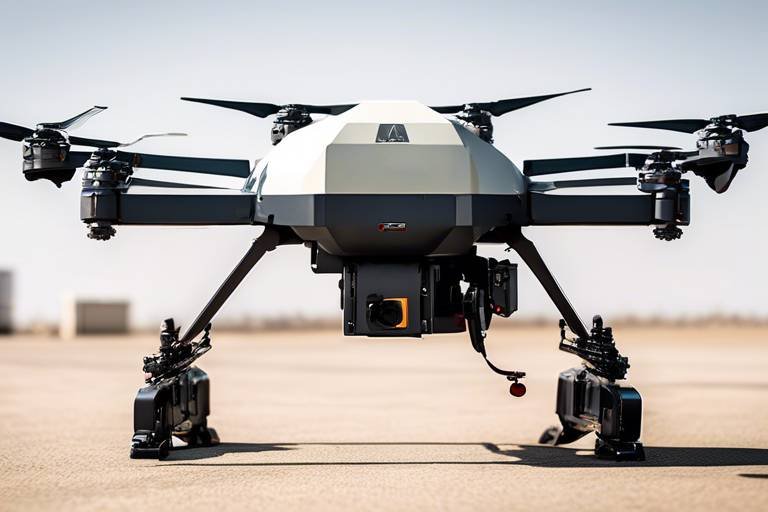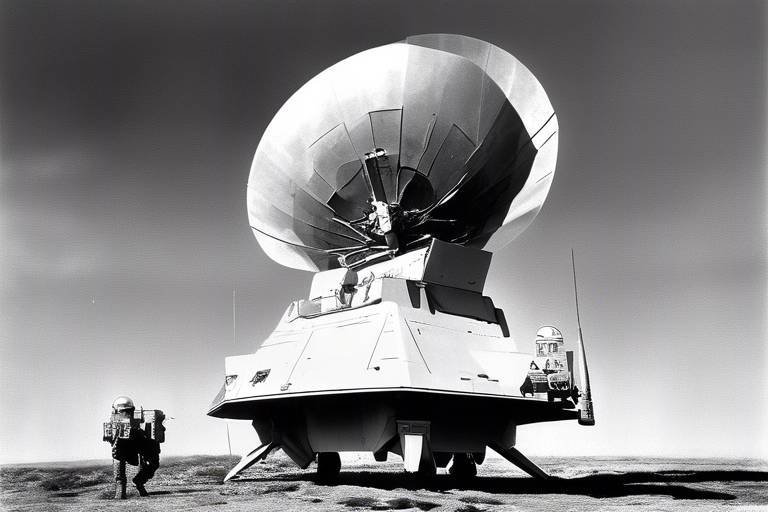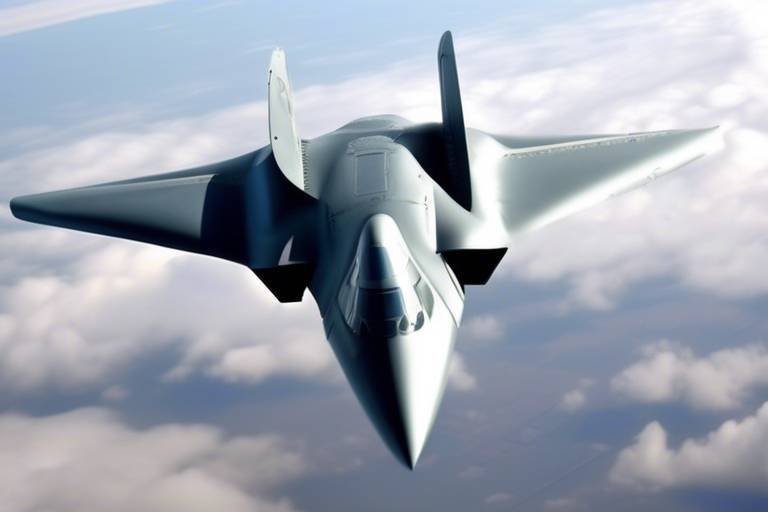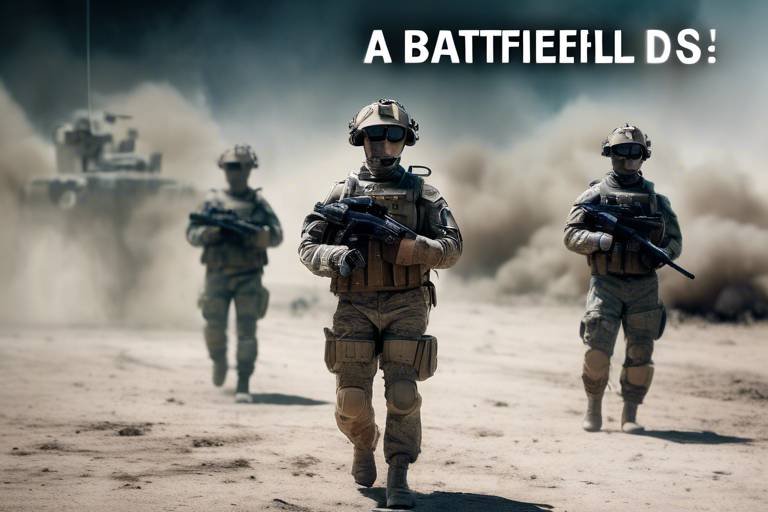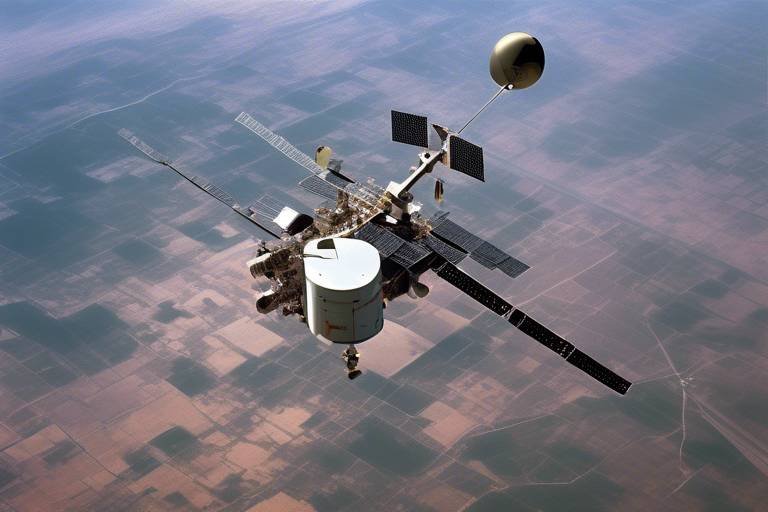Innovations in Tactical Gear for Enhanced Soldier Performance
In today's fast-paced and unpredictable battlefield, the importance of innovative tactical gear cannot be overstated. As soldiers face increasingly complex challenges, the gear they rely on must evolve to meet these demands. This article explores the latest advancements in tactical gear designed to improve soldier efficiency, safety, and overall performance on the battlefield, highlighting key technologies and materials shaping modern military equipment.
One of the most significant shifts in tactical gear is the introduction of innovative materials that are revolutionizing how soldiers operate. These materials are not just lightweight; they are also incredibly durable and weather-resistant. Imagine a soldier moving swiftly through a rain-soaked jungle, their gear impervious to the elements. This transformation enhances mobility and protection, ensuring that soldiers can perform optimally under challenging conditions. For instance, materials like Dyneema and Kevlar are being utilized to create armor that is both light and strong, allowing soldiers to carry more equipment without being bogged down.
The integration of smart technology into tactical gear is a game-changer. These advancements are enhancing situational awareness and communication among soldiers, providing real-time data and analytics that can significantly improve decision-making and operational effectiveness in the field. Imagine a soldier receiving immediate feedback about their surroundings or the status of their team through their gear. This level of connectivity can be the difference between mission success and failure.
Embedded health monitoring systems in tactical gear are allowing for real-time tracking of soldiers' vital signs. This technology ensures their well-being, enabling immediate medical response if necessary. Think of it as having a personal medic with you at all times. By monitoring heart rate, temperature, and other vital metrics, commanders can make informed decisions about troop deployment and safety, ultimately enhancing overall mission success.
Wearable sensors are another critical component of this technological evolution. These sensors provide feedback on physical exertion and fatigue levels, helping soldiers manage their endurance during prolonged missions. Picture a soldier in the heat of battle, suddenly aware that their energy levels are dropping, thanks to the feedback from their gear. This capability helps reduce the risk of injury or exhaustion, allowing soldiers to maintain peak performance.
Advanced GPS and navigation tools integrated into tactical gear facilitate precise location tracking and navigation. In unfamiliar terrains, these tools ensure soldiers can effectively maneuver while maintaining communication with their units. Imagine being in a dense forest, and your gear guides you to safety while keeping you connected with your team. This level of precision is invaluable in modern military operations.
The latest innovations in protective gear focus on balancing safety and mobility. With advanced ballistic materials and ergonomic designs, soldiers can be well-protected without compromising their agility and comfort. It's like wearing a second skin that shields you from harm while allowing you to move freely. This is crucial in high-stakes environments where every second counts.
Modular gear systems are gaining popularity among soldiers, allowing for a customized approach to equipment based on mission requirements. This means soldiers can carry only what is necessary for each operation, enhancing efficiency and reducing fatigue. Think of it as packing for a trip; you wouldn't carry unnecessary items, and neither should soldiers.
Interchangeable components in modular systems enable quick adjustments and adaptations in the field. Soldiers can switch out gear configurations rapidly based on evolving mission needs or environmental challenges. This flexibility is crucial in dynamic situations where conditions can change in an instant.
Innovative storage solutions integrated into tactical gear provide soldiers with organized and accessible compartments for essential equipment. In high-pressure situations, the ability to quickly retrieve necessary items can be a matter of life and death. Imagine a soldier reaching for a critical tool, knowing exactly where it is, without fumbling around. This level of organization can significantly enhance operational effectiveness.
- What are the latest materials used in tactical gear? Innovations like Dyneema and Kevlar are being utilized for their lightweight and durable properties.
- How does smart technology improve soldier performance? Smart technology enhances situational awareness and provides real-time data for better decision-making.
- What role do health monitoring systems play in tactical gear? They track vital signs, ensuring soldiers' well-being and enabling immediate medical response if necessary.
- What are modular gear systems? These systems allow soldiers to customize their equipment based on mission requirements, enhancing efficiency.

Advancements in Materials Technology
In the ever-evolving world of tactical gear, are at the forefront of enhancing soldier performance. Imagine a world where soldiers can traverse difficult terrains with ease, thanks to gear that is not only lightweight but also incredibly durable. This is no longer a distant dream; it’s a reality driven by innovative materials that are transforming military equipment. Modern tactical gear is now crafted from a variety of high-tech materials designed to withstand the rigors of the battlefield while ensuring maximum mobility.
One of the most significant breakthroughs is the use of synthetic fibers that are both strong and lightweight. These materials, such as Dyneema and Kevlar, offer exceptional resistance to abrasion and punctures, making them ideal for protective clothing and armor. Soldiers can now wear gear that feels almost weightless while still providing the necessary protection against ballistic threats. This balance between weight and safety is crucial, as it allows soldiers to move swiftly and effectively, reducing fatigue during long missions.
Moreover, the introduction of weather-resistant coatings on tactical gear is another game-changer. These coatings not only repel water but also resist dirt and stains, keeping the gear functional and looking sharp, even in the harshest conditions. Imagine trudging through muddy terrain or facing unexpected rain; with advanced materials, soldiers can focus on their mission rather than worrying about their gear. This is particularly important in environments where every second counts, and distractions can be detrimental to mission success.
Additionally, innovations such as breathable fabrics have been developed to enhance comfort. These materials allow for moisture wicking, ensuring that soldiers stay dry and comfortable, even during intense physical exertion. The ability to regulate body temperature is vital, especially in extreme climates, as it not only improves performance but also contributes to overall well-being. In this respect, the tactical gear evolves from mere protective clothing to a sophisticated ensemble that actively supports the soldier's physiological needs.
Furthermore, the integration of smart textiles is revolutionizing the way tactical gear functions. These advanced materials can incorporate sensors that monitor environmental conditions or even the soldier's health metrics. For instance, imagine a uniform that alerts a soldier if they are becoming dehydrated or overheating. This level of awareness can be lifesaving, allowing for timely interventions that can prevent heat-related illnesses or injuries.
To summarize, the advancements in materials technology are not just about making tactical gear lighter or more durable; they encompass a holistic approach to enhancing soldier performance. Here’s a quick overview of the key materials and their benefits:
| Material | Benefits |
|---|---|
| Dyneema | Lightweight, high strength, abrasion-resistant |
| Kevlar | Ballistic protection, durable |
| Weather-resistant coatings | Repels water, dirt, and stains |
| Breathable fabrics | Moisture-wicking, temperature regulation |
| Smart textiles | Health monitoring, environmental sensing |
As technology progresses, we can expect even more exciting developments in materials that will further enhance the effectiveness of tactical gear. The future holds the promise of gear that not only protects but also empowers soldiers to perform at their best, adapting to the challenges of modern warfare.
- What are the main benefits of advanced materials in tactical gear? Advanced materials provide lightweight, durable, and weather-resistant options that enhance soldier mobility and protection.
- How do smart textiles work? Smart textiles incorporate sensors that monitor health metrics and environmental conditions, providing real-time data to soldiers.
- Why is breathability important in tactical gear? Breathable fabrics help regulate body temperature and wick moisture away, keeping soldiers comfortable during physical exertion.
- What role do weather-resistant coatings play? These coatings help repel water, dirt, and stains, ensuring that gear remains functional and maintains its appearance in harsh conditions.

Smart Wearable Technology
The battlefield is evolving, and so is the technology that supports our soldiers. is at the forefront of this transformation, enhancing not just the efficiency of operations but also the safety and well-being of military personnel. Imagine a soldier equipped with a device that not only tracks their location but also monitors their health in real-time. This is no longer science fiction; it’s a reality that is reshaping modern warfare.
One of the most exciting aspects of smart wearable technology is its ability to improve situational awareness. Soldiers can receive critical information directly on their gear, such as enemy positions, weather updates, and mission changes, without needing to rely on cumbersome communication devices. This immediate access to real-time data allows for quicker, more informed decision-making in high-pressure situations. For instance, consider a soldier in a dense forest. With advanced smart goggles, they can see a digital overlay of their surroundings, highlighting potential threats and safe paths, effectively turning the chaos of battle into a navigable landscape.
Moreover, these technologies often include sophisticated health monitoring systems that track vital signs such as heart rate, temperature, and even hydration levels. This information is crucial; if a soldier is showing signs of fatigue or distress, commanders can be alerted instantly. This capability not only helps in preserving the soldier's health but also enhances mission success rates. In a scenario where every second counts, being able to proactively address health concerns can make all the difference.
Embedded within tactical gear, health monitoring systems are revolutionizing how we approach soldier care. These systems can send alerts when a soldier’s vitals fall outside the normal range, allowing for immediate medical intervention if necessary. This proactive approach ensures that soldiers can focus on their mission, knowing that their health is being monitored closely. The integration of these systems into wearable gear means that soldiers can move freely while still receiving essential health updates.
Another fascinating component of smart wearable technology is the use of wearable sensors. These devices provide critical feedback on physical exertion and fatigue levels, which is vital during prolonged missions. By monitoring physiological data, soldiers can better manage their endurance, helping them to avoid overexertion and potential injuries. Imagine a soldier on a long reconnaissance mission; with wearable sensors, they can gauge their energy levels and make informed decisions about when to rest or push forward, ultimately optimizing their performance.
In addition to health monitoring, advanced GPS and navigation tools are integrated into tactical gear to facilitate precise location tracking. This technology is indispensable for soldiers operating in unfamiliar terrains. With real-time GPS data, soldiers can navigate effectively, ensuring they remain on course and maintain communication with their units. The ability to pinpoint their location accurately not only enhances operational effectiveness but also significantly increases the safety of soldiers in the field.
In summary, the integration of smart wearable technology into tactical gear marks a significant leap forward in military operations. By enhancing situational awareness, monitoring health, and improving navigation, these innovations empower soldiers to perform at their best, even in the most challenging environments. As technology continues to advance, we can expect even more groundbreaking developments that will further transform the landscape of military equipment.
- What is smart wearable technology in tactical gear?
Smart wearable technology refers to devices integrated into military equipment that monitor health, provide real-time data, and enhance communication and navigation capabilities for soldiers. - How does health monitoring contribute to soldier safety?
Health monitoring systems track vital signs and can alert commanders to potential health issues, allowing for immediate medical response and ensuring that soldiers are fit for duty. - Can smart wearables improve decision-making on the battlefield?
Yes, by providing real-time information and situational awareness, smart wearables help soldiers make quicker and more informed decisions during missions. - What kind of data do wearable sensors track?
Wearable sensors typically track physiological data such as heart rate, fatigue levels, and hydration status to help manage soldier performance.

Health Monitoring Systems
In today's fast-paced battlefield environments, the health and well-being of soldiers are paramount. That's where come into play, revolutionizing the way military personnel can track their physical condition in real-time. Imagine being on a mission, and instead of relying solely on your own instincts to gauge fatigue or stress levels, you have a sophisticated system that provides immediate feedback. This technology is not just a luxury; it’s becoming a necessity for enhancing mission success.
These systems are embedded directly into tactical gear, allowing soldiers to monitor vital signs such as heart rate, body temperature, and oxygen levels without any cumbersome devices. This seamless integration means that soldiers can focus on their tasks without being distracted by additional equipment. For instance, if a soldier’s heart rate spikes unexpectedly, the system can alert them and their commanding officer, enabling timely medical interventions. This capability can be a game-changer, particularly in high-stress scenarios where every second counts.
Moreover, health monitoring systems can be crucial for preventing injuries. They offer insights into physical exertion and fatigue levels, which help soldiers manage their energy during prolonged missions. By continuously tracking performance metrics, these systems can provide actionable data, allowing soldiers to optimize their efforts and avoid overexertion. For example, if a soldier is nearing their physical limits, the system can suggest taking a break or adjusting their pace, much like a coach guiding an athlete during a critical match.
In addition to monitoring vital signs, many of these systems feature data analytics capabilities. This means that not only can they track immediate health metrics, but they can also analyze trends over time. Commanders can review this data to identify patterns that may indicate when soldiers are at risk of burnout or injury, enabling proactive measures to be taken. The integration of such technology represents a significant leap forward in how military operations can prioritize soldier welfare.
As we look towards the future, the potential applications of health monitoring systems are vast. Imagine a scenario where real-time health data is shared among units, allowing for coordinated medical responses during combat. The ability to monitor the health of an entire squad or platoon could enhance operational effectiveness and save lives. In this way, these systems not only enhance individual performance but also contribute to overall mission success.
In summary, health monitoring systems are transforming the landscape of tactical gear. By providing real-time data on soldiers' health, these systems help ensure that personnel can perform at their best while minimizing risks. The marriage of technology and military operations is paving the way for a safer and more efficient battlefield experience.
- What are health monitoring systems? Health monitoring systems are integrated technologies within tactical gear that track soldiers' vital signs and physical performance in real-time.
- How do these systems enhance soldier safety? They provide immediate feedback on health metrics, allowing for timely medical interventions and reducing the risk of injury or fatigue.
- Can health monitoring systems be used in all environments? Yes, these systems are designed to function effectively in various environmental conditions, ensuring soldiers' health is monitored regardless of location.
- What types of data can these systems track? Health monitoring systems can track heart rate, body temperature, oxygen levels, and other vital signs, as well as provide analytics on physical exertion and fatigue.

Wearable Sensors
In the ever-evolving landscape of tactical gear, are emerging as game-changers for soldier performance. Imagine a soldier on the battlefield, equipped not just with weapons and armor, but with a suite of sensors that monitor their physical state in real-time. These sensors are designed to track vital metrics such as heart rate, body temperature, and even hydration levels. This technology is akin to having a personal coach by your side, providing crucial feedback that can mean the difference between success and failure in high-stakes situations.
One of the most significant advantages of wearable sensors is their ability to monitor physical exertion and fatigue levels. For instance, during a prolonged mission, soldiers can easily overexert themselves, leading to exhaustion or injury. With wearable sensors, they receive alerts when their body is reaching its limits, allowing them to manage their endurance more effectively. This proactive approach not only helps in maintaining peak performance but also plays a vital role in ensuring their safety.
Moreover, these sensors can be integrated with other smart wearable technologies, creating a comprehensive health monitoring system. For example, if a soldier's heart rate spikes beyond a certain threshold, the system can automatically alert medics or command units, facilitating a swift medical response. This level of connectivity and data sharing is revolutionary; it transforms the traditional view of battlefield medicine into a more responsive and informed practice.
In addition to health monitoring, wearable sensors can also provide valuable data for mission planning and execution. By analyzing the physical demands placed on soldiers during various operations, military strategists can better understand the human factors involved in combat scenarios. This data-driven approach allows for adjustments in training, gear selection, and even mission design, ultimately enhancing the effectiveness of military operations.
As we look towards the future, the integration of wearable sensors into tactical gear is not just about enhancing performance; it’s about redefining soldier safety. The potential for these devices to save lives and improve mission outcomes is immense. With ongoing advancements in technology, we can expect to see even more sophisticated sensors that are lighter, more accurate, and seamlessly integrated into the fabric of tactical uniforms.
- What are wearable sensors in tactical gear?
Wearable sensors are advanced devices embedded in tactical gear that monitor vital signs and physical exertion levels of soldiers, providing real-time feedback on their health and performance.
- How do wearable sensors improve soldier safety?
By tracking vital metrics such as heart rate and fatigue, wearable sensors can alert soldiers and medics to potential health risks, enabling timely medical responses and reducing the risk of injury.
- Can wearable sensors be used in conjunction with other technologies?
Yes, wearable sensors can integrate with other smart technologies to create comprehensive health monitoring systems that enhance situational awareness and decision-making.
- What future advancements can we expect in wearable sensor technology?
Future advancements may include even lighter sensors, improved accuracy, and more seamless integration into tactical gear, further enhancing soldier performance and safety.

GPS and Navigation Tools
In the fast-paced and often unpredictable environment of the battlefield, having reliable is not just a luxury; it’s a necessity. Imagine being in unfamiliar territory, surrounded by unknown threats, and the only thing standing between you and mission success is your ability to navigate effectively. This is where cutting-edge GPS technology comes into play, transforming the way soldiers operate in the field.
Modern tactical gear is now equipped with advanced GPS systems that provide precise location tracking, enabling soldiers to maneuver with confidence. These systems are designed to offer real-time updates, which can be crucial during critical moments. For instance, if a squad needs to reposition quickly due to enemy activity, having accurate GPS data can save valuable time and potentially lives.
One of the standout features of these navigation tools is their integration with other smart technologies. Many systems now include augmented reality (AR) capabilities, allowing soldiers to visualize their surroundings through a digital lens. This means they can see not only their current location but also relevant information about the terrain, enemy positions, and even routes that are less prone to ambush. It's like having a tactical map that updates in real-time, adapting to the ever-changing battlefield landscape.
Moreover, the durability and weather resistance of these GPS devices ensure that they function optimally under various environmental conditions. Whether it's rain, snow, or extreme heat, soldiers can rely on their navigation tools to perform without fail. This resilience is vital, as any malfunction in navigation could lead to disorientation and increased vulnerability.
To further enhance operational effectiveness, many GPS systems are equipped with features such as:
- Waypoint Navigation: Allows soldiers to mark and navigate to specific points of interest quickly.
- Route Optimization: Suggests the most efficient paths based on current conditions and threats.
- Communication Integration: Syncs with communication devices to share locations with team members seamlessly.
In conclusion, the incorporation of GPS and navigation tools in tactical gear is a game-changer for modern military operations. They not only provide soldiers with the ability to navigate effectively but also enhance their situational awareness, making them more agile and responsive in the face of challenges. As technology continues to advance, we can only anticipate even more innovative solutions that will further empower our soldiers on the ground.
Q: How does GPS technology improve soldier safety?
A: GPS technology enhances soldier safety by providing accurate location tracking, enabling quick navigation and communication during missions, and allowing for real-time updates on surrounding threats.
Q: Can GPS devices work in extreme weather conditions?
A: Yes, modern GPS devices are designed to be durable and weather-resistant, ensuring they function effectively in a variety of environmental conditions.
Q: What are some key features of advanced GPS systems in tactical gear?
A: Key features include waypoint navigation, route optimization, and communication integration, all of which enhance operational effectiveness and situational awareness.

Enhanced Protective Gear
When it comes to enhancing soldier performance on the battlefield, one of the most critical aspects is protective gear. The latest innovations in this field focus on achieving a delicate balance between safety and mobility. Soldiers need to be well-protected from various threats, yet they must also retain their agility and comfort to perform optimally. Recent advancements in ballistic materials have led to the development of gear that is not only lighter but also more effective at stopping projectiles. Imagine wearing a suit of armor that feels as light as a feather yet offers the same level of protection as traditional heavy gear—this is the reality of modern tactical equipment.
One of the standout features of enhanced protective gear is its ergonomic design. This innovation ensures that the gear conforms to the natural shape of the body, allowing for greater freedom of movement. For instance, soldiers can now engage in high-intensity activities like sprinting or climbing without feeling restricted by their equipment. This is crucial during combat situations where every second counts, and the ability to move swiftly can make all the difference. The integration of advanced cushioning materials also helps in absorbing impact, reducing the risk of injury during sudden falls or collisions.
Moreover, the incorporation of multi-threat protection features allows soldiers to face a variety of dangers without needing to switch gear. For example, some modern vests are designed to provide protection against not only bullets but also shrapnel and even chemical agents. This versatility means that soldiers can be prepared for a range of scenarios without being weighed down by multiple layers of equipment. To further illustrate this, take a look at the table below that highlights some of the key features of enhanced protective gear:
| Feature | Description |
|---|---|
| Lightweight Materials | Utilizes advanced composites that reduce weight while maintaining high levels of protection. |
| Ergonomic Design | Conforms to the body for improved mobility and comfort. |
| Multi-Threat Protection | Offers defense against bullets, shrapnel, and chemical agents. |
| Impact Absorption | Incorporates cushioning materials to minimize injury from falls or impacts. |
In addition to these features, the use of breathable fabrics ensures that soldiers can stay cool and dry, even in high-stress environments. This is particularly important during prolonged missions where heat buildup can lead to fatigue and decreased performance. Imagine running a marathon in a heavy, non-breathable suit—it would be exhausting! But with the right gear, soldiers can maintain their stamina and focus, which is vital for mission success.
Overall, the innovations in enhanced protective gear represent a significant leap forward in military technology. By prioritizing both safety and mobility, these advancements not only protect soldiers but also empower them to perform at their best. As we continue to explore new materials and designs, the future of tactical gear looks promising, ensuring that our soldiers are equipped to face the challenges of modern warfare.
- What are the main benefits of enhanced protective gear?
The main benefits include improved safety from various threats, increased mobility, and greater comfort during missions. - How does ergonomic design improve soldier performance?
Ergonomic design allows for a natural range of motion, reducing fatigue and enabling quicker responses in critical situations. - What materials are commonly used in modern protective gear?
Modern protective gear often utilizes advanced composites, breathable fabrics, and impact-absorbing materials to enhance performance. - Can enhanced protective gear protect against multiple threats?
Yes, many modern protective gear options are designed to offer multi-threat protection, including defense against bullets, shrapnel, and chemical agents.

Modular Gear Systems
In the ever-evolving landscape of military operations, have emerged as a game-changer for soldiers on the battlefield. These systems are designed to be flexible and adaptable, allowing each soldier to customize their gear according to the specific demands of their mission. Imagine a chef who can choose their utensils based on the dish they are preparing; modular gear works in a similar way, enabling soldiers to select only the equipment they need, which can significantly enhance their efficiency and reduce unnecessary weight.
One of the standout features of modular gear systems is their interchangeable components. This means that soldiers can quickly swap out different parts of their gear based on real-time needs. For instance, if a soldier finds themselves needing additional storage for medical supplies during an operation, they can easily attach a compatible pouch without having to carry an entire new bag. This adaptability not only saves time but also ensures that soldiers remain agile and prepared for any situation.
Moreover, the design of these systems promotes streamlined storage solutions. Gone are the days of rummaging through bulky packs to find essential gear. With innovative compartmentalization integrated into modular systems, soldiers can enjoy organized and accessible storage that allows them to retrieve items swiftly, especially during high-pressure scenarios. This organization can be the difference between success and failure in critical moments.
To further illustrate the efficiency of modular gear systems, consider the following table that highlights key benefits:
| Feature | Benefit |
|---|---|
| Interchangeable Components | Quick adjustments based on mission needs |
| Customizable Configurations | Personalized gear for enhanced performance |
| Organized Storage | Easy access to essential equipment |
| Weight Reduction | Less fatigue and improved mobility |
In conclusion, modular gear systems are not just a trend; they represent a significant advancement in tactical equipment. By providing soldiers with the ability to tailor their gear to meet the unique challenges of each mission, these systems enhance overall operational effectiveness. As the military continues to embrace innovation, we can expect modular systems to become even more sophisticated, further improving the safety and efficiency of our troops.
- What are modular gear systems? Modular gear systems are customizable equipment setups that allow soldiers to adapt their gear based on mission requirements.
- How do interchangeable components work? Interchangeable components allow soldiers to quickly change out parts of their gear, such as pouches or attachments, to suit different operational needs.
- What are the benefits of organized storage in modular gear? Organized storage ensures that soldiers can easily access essential items, reducing time spent searching for gear during critical moments.
- Can modular gear systems help reduce fatigue? Yes, by allowing soldiers to carry only what they need, modular systems can reduce overall weight, leading to less fatigue and improved mobility.

Interchangeable Components
The concept of in tactical gear is a game-changer for modern soldiers. Imagine being able to adapt your gear on-the-fly, much like a chameleon changes its colors to blend into its surroundings. This flexibility is not just about convenience; it's about survival and efficiency in the field. With the demands of various missions, soldiers need to be equipped with the right tools for the job, and interchangeable components make that possible.
These modular systems allow soldiers to quickly swap out different parts of their gear depending on the specific needs of their operation. For instance, a soldier might need a heavier ballistic vest for a high-risk mission, while a lighter, more breathable option could be perfect for a reconnaissance task. This adaptability ensures that soldiers are not weighed down unnecessarily, enhancing their mobility and reaction times.
Moreover, the design of these components is often user-friendly, allowing for swift adjustments even in high-pressure situations. Consider a soldier in the field who suddenly needs to switch from a standard loadout to a more specialized setup. With interchangeable components, they can make this transition seamlessly. This capability can be critical when every second counts, and the ability to pivot can mean the difference between mission success and failure.
Additionally, the integration of interchangeable components promotes a sense of ownership and personalization among soldiers. They can tailor their gear to suit their unique preferences and operational requirements. This customization not only boosts morale but also enhances overall performance, as soldiers feel more comfortable and confident in their equipment. It's akin to a musician choosing their favorite instrument; the right gear can amplify their effectiveness.
To further illustrate the benefits of interchangeable components, let's take a look at a simple comparison table:
| Component Type | Standard Gear | Interchangeable Gear |
|---|---|---|
| Weight | Heavier, fixed | Lightweight, customizable |
| Adaptability | Limited | High, quick adjustments |
| User Experience | Uniform | Personalized, tailored |
| Mission Suitability | One-size-fits-all | Mission-specific options |
In summary, interchangeable components in tactical gear not only provide practical advantages but also enhance the overall soldier experience. As technology continues to evolve, we can expect even more innovations in this area, leading to gear that not only meets the rigorous demands of the battlefield but also empowers the individuals who wear it.
- What are interchangeable components in tactical gear?
Interchangeable components refer to modular parts of tactical gear that can be easily swapped out or adjusted based on mission requirements, allowing for greater flexibility and customization. - How do interchangeable components improve soldier performance?
They enhance soldier performance by providing the right gear for specific missions, reducing unnecessary weight, and allowing for quick adaptations in the field. - Are interchangeable components user-friendly?
Yes, most modular systems are designed for ease of use, enabling soldiers to make adjustments quickly, even in high-pressure situations.

Streamlined Storage Solutions
In the fast-paced and unpredictable environment of the battlefield, having efficient storage solutions is not just a convenience; it's a necessity. Soldiers need to be able to access their gear quickly and efficiently, especially during high-stress situations where every second counts. That's where come into play, revolutionizing how military personnel organize and retrieve their essential equipment. These innovative designs focus on maximizing space while ensuring that every item is within easy reach, effectively reducing the time spent searching for gear.
Imagine a soldier in the heat of a mission, needing to grab a specific tool or piece of equipment. Traditional gear often leads to fumbling around in a disorganized pack, wasting precious time. However, with modern storage solutions, compartments are tailored to fit specific items, allowing for quick identification and retrieval. For instance, pockets are now strategically placed and labeled, ensuring that everything from ammunition to medical supplies is organized and accessible at a moment's notice.
Moreover, these storage solutions are designed to adapt to various mission profiles. Whether a soldier is on a reconnaissance mission, engaging in combat, or providing humanitarian aid, the ability to customize storage is crucial. Many tactical vests and backpacks now come equipped with modular compartments that can be rearranged or removed entirely, depending on the mission's requirements. This flexibility not only enhances efficiency but also reduces the overall weight soldiers must carry, ultimately leading to improved endurance and performance.
Another exciting development in this area is the integration of smart technology into storage solutions. Imagine having a tactical backpack that can notify you if an item is missing or misplaced. These intelligent systems can keep track of gear through RFID tags or similar technologies, ensuring that soldiers have everything they need before heading into action. This level of organization is invaluable, particularly in chaotic environments where the stakes are high.
To further illustrate the impact of streamlined storage solutions, consider the following table that compares traditional storage methods with modern innovations:
| Feature | Traditional Storage | Modern Storage Solutions |
|---|---|---|
| Accessibility | Often disorganized, leading to delays | Quick access with organized compartments |
| Customization | Fixed compartments with limited options | Modular systems allow for personalized setups |
| Weight Management | Heavy and bulky gear | Lightweight designs reduce fatigue |
| Smart Features | No tracking or notification systems | Integrated tech for gear management |
In conclusion, the evolution of storage solutions in tactical gear is a game-changer for soldiers. By prioritizing accessibility, customization, and smart technology, these innovations not only enhance performance but also contribute to the overall safety and effectiveness of military operations. As we continue to advance in technology and design, the future looks bright for streamlined storage solutions, ensuring that our soldiers are always prepared for whatever challenges lie ahead.
- How do modern storage solutions improve soldier efficiency? Modern storage solutions enhance soldier efficiency by providing organized compartments for quick access to essential gear, reducing the time spent searching for items.
- Can soldiers customize their storage solutions based on mission needs? Yes, many modern tactical gear systems are modular, allowing soldiers to customize their storage based on the specific requirements of each mission.
- What role does smart technology play in storage solutions? Smart technology can track gear and notify soldiers of missing items, ensuring they have everything needed before heading into action.
- Are these storage solutions lightweight? Yes, modern storage solutions are designed to be lightweight, helping to reduce fatigue and improve overall soldier performance.
Frequently Asked Questions
- What are the latest advancements in tactical gear?
The latest advancements in tactical gear include innovative materials that are lightweight, durable, and weather-resistant. These materials enhance soldier mobility and protection, allowing them to perform optimally in various challenging environments.
- How does smart wearable technology improve soldier performance?
Smart wearable technology enhances soldier performance by providing real-time data and analytics. This technology improves situational awareness and communication among soldiers, significantly boosting decision-making and operational effectiveness in the field.
- What role do health monitoring systems play in tactical gear?
Health monitoring systems embedded in tactical gear track soldiers' vital signs in real-time. This capability ensures their well-being and enables immediate medical response if necessary, ultimately enhancing overall mission success.
- How do wearable sensors benefit soldiers during missions?
Wearable sensors provide critical feedback on physical exertion and fatigue levels. This information helps soldiers manage their endurance and optimize performance during prolonged missions, reducing the risk of injury or exhaustion.
- What features do advanced GPS and navigation tools offer?
Advanced GPS and navigation tools integrated into tactical gear facilitate precise location tracking and navigation. This ensures soldiers can effectively maneuver in unfamiliar terrains and maintain communication with their units.
- What innovations are found in enhanced protective gear?
The latest innovations in protective gear focus on balancing safety and mobility. They utilize advanced ballistic materials and ergonomic designs to ensure soldiers are well-protected without compromising their agility and comfort.
- What are modular gear systems and how do they work?
Modular gear systems allow soldiers to customize their equipment based on mission requirements. This ensures they carry only what is necessary for each operation, enhancing efficiency and reducing fatigue.
- How do interchangeable components in modular systems function?
Interchangeable components in modular systems enable quick adjustments and adaptations in the field. Soldiers can rapidly switch out gear configurations based on evolving mission needs or environmental challenges.
- What are streamlined storage solutions in tactical gear?
Streamlined storage solutions integrated into tactical gear provide organized and accessible compartments for essential equipment. This ensures soldiers can quickly retrieve necessary items during high-pressure situations, making operations smoother and more efficient.


